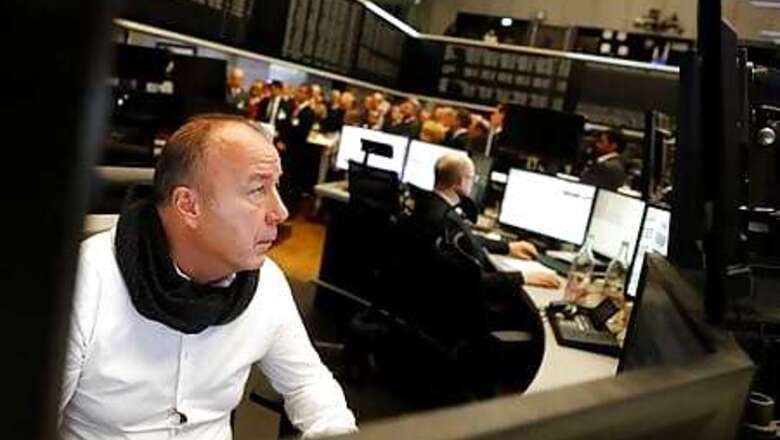
views
NEW YORK The dollar bounced off two-year lows and a gauge of global equity markets halted its march toward a record high on Friday, as better-than-expected U.S. jobs growth in July was tempered by the wrangles in Washington over a new stimulus bill.
Big rallies in gold and the euro were also snapped.
The U.S. Labor Department’s data showed slowing employment growth in July amid a surge in COVID-19 cases, highlighting the need for the White House and Congress to agree on an aid package.
Gold slid 2%, after hitting a record high earlier in the week, the euro fell from highs against the dollar last seen in May 2018 and U.S. Treasury yields rose, halting a downward move that had the benchmark 10-year note poised to fall below 0.5%.
The sell-off was due to profit-taking after the record peaks this week in gold and the tech-driven Nasdaq, and as the value of the dollar ebbed, said Axel Merk, president and chief investment officer of Merk Investments LLC in San Francisco.
“We’ve had such a dramatic move. It’s been dollar-centric, call it a profit-taking reversal. I don’t think there is a change in environment,” said Merk.
European equities eked out modest gains, with the pan-regional FTSEurofirst 300 index adding 0.27%. But the euro’s sharpest sell-off since April helped Germany’s export-heavy DAX index to close up 0.66%.
Stocks on Wall Street meandered, with the S&P 500 and Dow in negative territory most of the session before turning positive at the close.
The Dow Jones Industrial Average rose 0.17%, the S&P 500 gained 0.06% and the Nasdaq Composite dropped 0.87%. The declines snapped the Nasdaq’s seven-session streak of gains.
MSCI’s benchmark for global equity markets fell 0.36% to 563.11. The index for stock performance in 49 countries rose 0.7% for the week and is about 3% away from its record peak set in February.
The dollar index rose 0.648%, with the euro down 0.77% to $1.1783. The Japanese yen weakened 0.41% versus the greenback at 105.97 per dollar.
The U.S. labor market report defied the market’s downside fears with solid job gains in July, allowing the dollar to rally into the weekend and the markets to breath a sigh of relief, said a report from Action Economics.
Financial markets remain focused on the potential passage of another stimulus bill in Congress, but the White House and Democrats appear far apart after nearly two weeks of talks that have failed to produce substantial progress.
Democrats in Congress said on Friday they offered to reduce their proposed coronavirus aid package by a trillion dollars if Republicans would add a trillion to their counter-offer, but the idea was flatly rejected by the White House.
Also weighing on markets was President Donald Trump’s sweeping ban, unveiled late Thursday, on U.S. transactions with the Chinese owners of messaging app WeChat and video-sharing app TikTok.
In response, China said the companies complied with U.S. laws and warned Washington would have to “bear the consequences” of its action.
Chinese stocks led losers in Asia and the yuan slumped after Trump issued executive orders to purge “untrusted” Chinese apps TikTok and WeChat from U.S. digital networks.
Hong Kong’s Hang Seng fell 1.6%. Tencent , Asia’s second-biggest company by market capitalization and the owner of WeChat, dropped as much as 10.1% and closed down 5.0%.
Mainland China’s CSI 300 Index fell 1.15% despite strong export data, while Japan’s Nikkei slipped 0.4%.
The latest Bank of America fund flow statistics also confirmed the undercurrent of caution in global markets, with investors flocking to cash, gold and investment-grade bonds and switching out of equities.
Gold hit a record high of $2,072.5 an ounce overnight in Asia, before succumbing to profit-taking.
Spot gold prices fell -1.59% to $2,030.34 an ounce.
U.S. gold futures settled down 2% at $2,028.
Silver dropped 2.9% to $28.09 an ounce after rising to a seven-year high of $29.838 on Thursday.
Oil prices fell nearly 2%, limiting their weekly gain due to concerns the global recovery could falter from a surge in coronavirus cases. The rise in infections remains the dominant issue for the fuel demand outlook.
Brent crude futures slid 69 cents to settle at $44.40 a barrel, while U.S. crude futures settled down 73 cents at $41.22 a barrel.
Disclaimer: This post has been auto-published from an agency feed without any modifications to the text and has not been reviewed by an editor


















Comments
0 comment